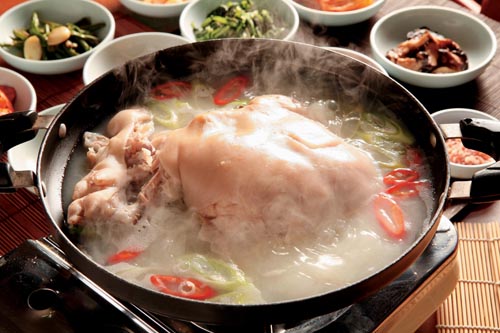The sad story behind one of the country’s rarest dishes

Aejeojjim is rare but still served in Korea today. Provided by the Korea Tourism Organization
The story behind ajeojjim, a traditional Korean dish of steamed pig fetus, is tragic. Although the dish is not well-known today, it used to be popular during harsher times when food was less abundant.
Before the Joseon Dynasty (1392-1897), many farmers raised pigs because they were easy to feed and produced around eight to 15 piglets once every three months.
But while many farmers raised pigs, they could not afford to eat pork very often themselves. So when a pregnant pig died or gave birth to a stillborn piglet, the farmer’s family would use the fetal pig to make aejeojjim, which in Chinese characters translates to “sad steamed pork.” But the sad story doesn’t end there.
Aejeojjim started off as a dish eaten by poor farmers in rural areas but by the late Joseon Dynasty, the dish had become popular among rich merchants.
Many of these merchants had earned a fortune by cooperating with the government in return for exclusive rights to build a monopoly. These newly rich families enjoyed extravagant food and, quite ironically, aejeojjim became one of the dishes they enjoyed.
With the rapid increase in demand, pig farmers had to start slaughtering mother pigs to produce the meat for the dish, which ultimately raised its price.
Nowadays, aejeojjim is difficult to find in restaurants but it is still sold in Jinan, North Jeolla, and a few other areas in Korea.
Jinan, which is a dense mountain area, is not conducive to plant growth so pig farming was an important industry there. Eventually, the area became famous for its aejeojjim and decades-old aejeojjim restaurants remain open there today.
To prepare the dish, the internal organs of the fetal pig are removed and it is stuffed with tofu, cabbage, garlic, green onion and various spices and then steamed for a long time. The taste of the pork is said to be something more like chicken.
Since it was steamed for a long time and is from a pig fetus, the meat is also more tender than the meat of mature animals that are slaughtered for meat.
Aejeojjim restaurants serve the dish in a boiling pot and the dish serves up to four people. A spicy soup is usually served after the main dish to cleanse the palate of the greasiness of the pork and provide a light finish to the meal.
By Oh Yoon Contributing writer [estyle@joongang.co.kr]










with the Korea JoongAng Daily
To write comments, please log in to one of the accounts.
Standards Board Policy (0/250자)